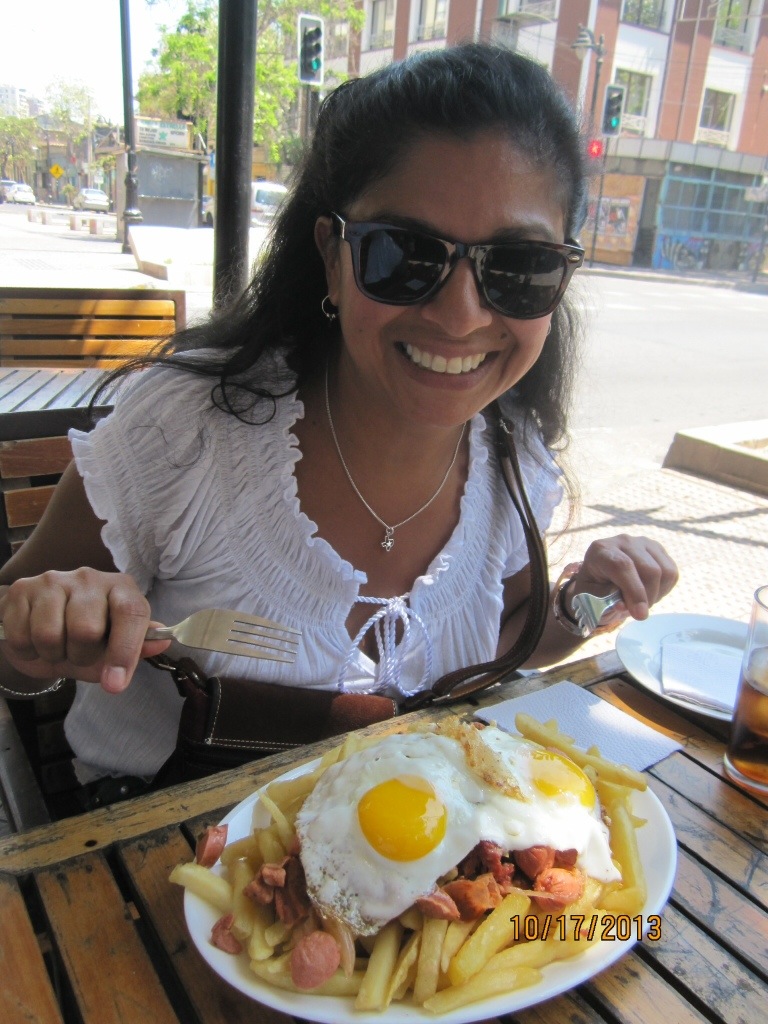Time to slow it down….way down. Jessica and I have been traveling like mad since leaving the US on August 6th. Costa Rica, our first country, seems so long ago now. Then came Ecuador followed by Peru. Bish-Bam-Boom! It may not seem like that much to list them, but realize that each country has granted us thousands of new memories and…well, it is a heckuva lot. One glance back at the 11 posts I have made to this travel blog and all that we have done and seen becomes abundantly clear.
Now we are in Santiago, Chile and staying put for about a month. This means a whole different kind of world travel experience. In essence, we are living in another country. Granted, it’s just for one month, but that is still a sufficient amount of time for us to see the world (and our place in it) from a perspective neither of us has ever had before.
Why Chile? Why now? What are we doing here? Good questions all. Choosing to pause our hectic travel schedule at this point in time and in this place was a little bit arbitrary. Basically, we figured after two straight months of travel we might like a break-y-poo. Plus, we had not done any detailed planning of our trip beyond the first three countries. And finally, future planning from this point can now benefit from our experiences and inform our travel methods and pace going forward.
There was so much to say about this portion of our trip that I split my post into two parts.
Our New (Temporary) Life
As soon as we arrived into Santiago our hunt for a semi-permanent place to stay began in earnest. We used AirBnB.com and quickly found a tiny but suitable one bedroom apartment in a middle-class part of Santiago known as Ñuñoa (so very awkward to pronounce). We feel really comfortable here. There is a nice park right down the street, two nearby grocery stores (and one newly built mall), and multiple bus stops all within a stone’s throw. We paid $870 for the entire month of October. That comes to about $30/day, right in-line with our budget. Check this out, our building even has its own doorman and weekly maid service for our apartment. Woot! And best of all (for me at least), there is Ultimate being played on fields just five minutes away from here on a (borrowed) bicycle.
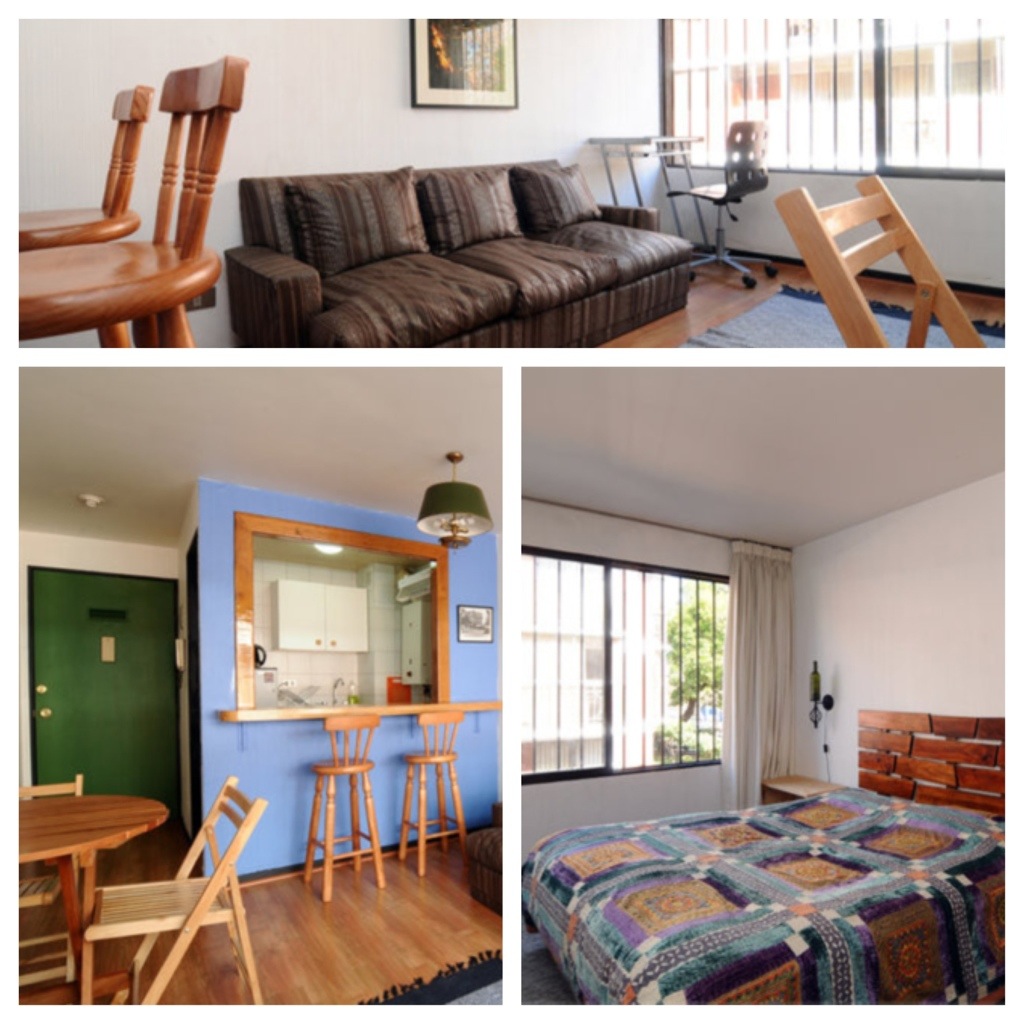
The shift from travel-like-crazy to let’s slow-it-down-for-a-month contained a few interesting surprises for us. It was the little things that tickled– we bought toilet paper for the first time in ages. Fun! Both of us had on and off stuffy noses so we bought a couple of boxes of tissue for our apartment. So cool! Mayonnaise, mustard, bread, cheese, lettuce, tomatoes…all our normal stuff. So very ordinary, which I guess is what made it so comforting.
Who’s ready to start their own business? Coin-operated laundromats in Santiago could be the next big idea. They don’t exist here. [Okay, that is not strictly true, we found there is actually one here, but located too far away to help us.] Whenever we needed to wash clothes in Costa Rica, Ecuador or Peru, we either did it ourselves in the sink or took it to a neighborhood laundry service. We had assumed (incorrectly) that once in Santiago we could do our own laundry at a laundromat. That didn’t happen. The good news is that every grocery store has its own laundry service counter inside, so that’s convenient. We are just not fans of having to pay $8.50 per load.
Being stationary for a while has allowed us to catch up on some movies. We saw Gravity, Elysium and The Heat. All were worthy! (Hmmm, Sandra Bullock was in two-thirds of the movies we’ve seen while in Santiago. Go Sandy!) We also went to a nearby community theater and saw a free show of Flamenco dancing. That was an enjoyable night out.
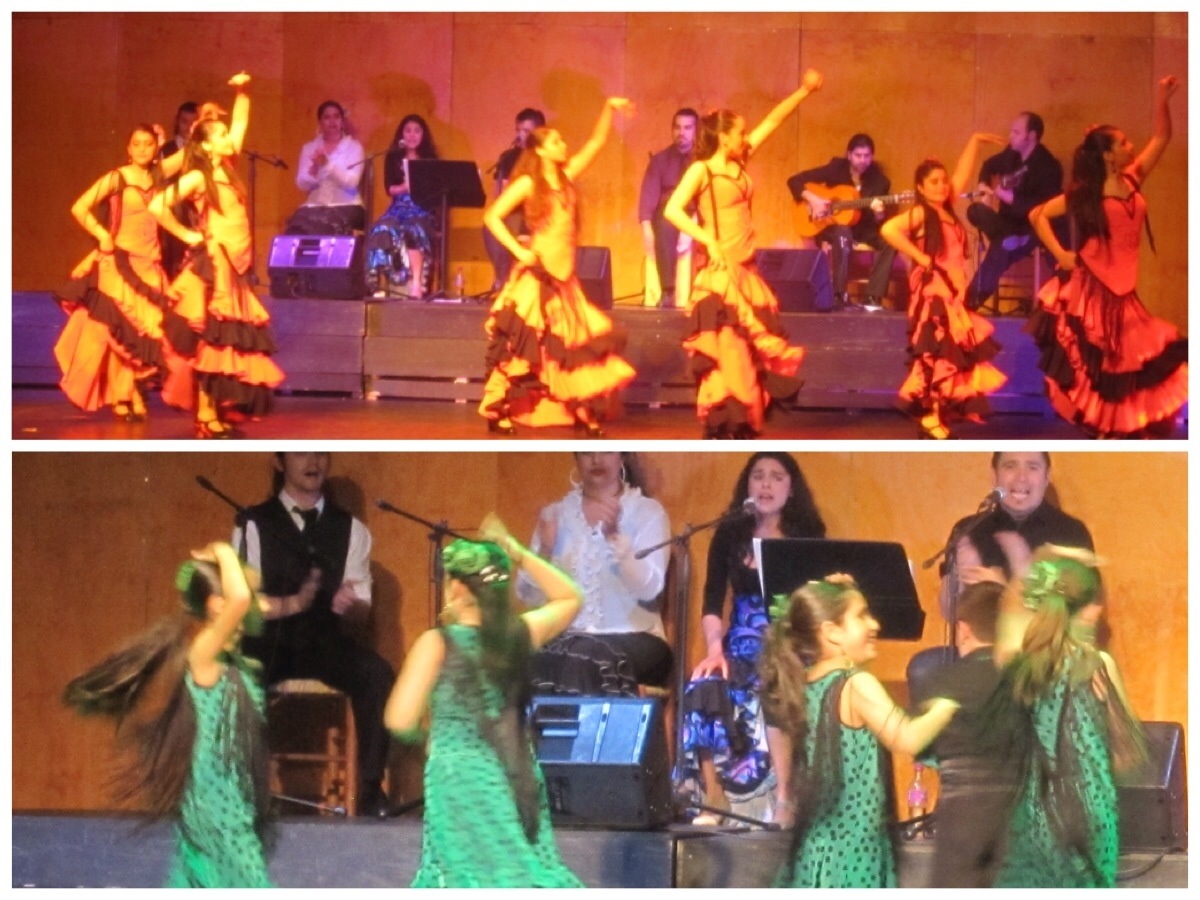
My Confession of Ignorance
Prior to this current trip to South America, Peru was the only South American country to which I had ever traveled. Jessica had never been anywhere in South America. Ignorantly, I had mentally lumped all South American countries into a similar bucket and assumed they were all more or less on the poorer end of the economic development scale. I was quite wrong. As represented by Santiago, the country of Chile is a world away from both Peru and Ecuador in terms of economic development and modernization. Chile is a 1st world country without a doubt. Yes, here you can drink the water right from the tap and no, they don’t drive like maniacs. Some of their driving habits even come pretty close to awesome. If we are crossing the street at a pedestrian crosswalk, even ones without any traffic signals, the cars will stop and wait for us as if we had thrown magic powder in their faces.
This crosswalk has signals, and check out those moves…
Further surprises were: one- just how expensive everything (except wine) is, and two- just how horrible Chilean food is. When traveling throughout Peru, we were warned that Chilean food is not very good. We assumed that was harmless smack talk between neighboring countries. But nooooo! In our experience so far, it’s just plain true. Chilean food is…um…uh…lackluster. Calling it bad or horrible may be too harsh, but in our honest opinion we have found that Chilean food has very little to offer in terms of taste. And then the fact that it cost so much is insult to injury. Since we have full use of a kitchen in our little apartment we are preparing most of our own meals. Occasionally, we venture out to a restaurant, but after getting burned a few times we not eager to go out and spend $12 – $18 on a plate of food only to come away disappointed.
We did a 4-hour walking tour of Santiago the first week we were here. It was a great tour in 18 different ways. Our guide (Franco) spoke very good English and filled the tour with great stories from Chile’s history. Here we are in front of the President’s office building.
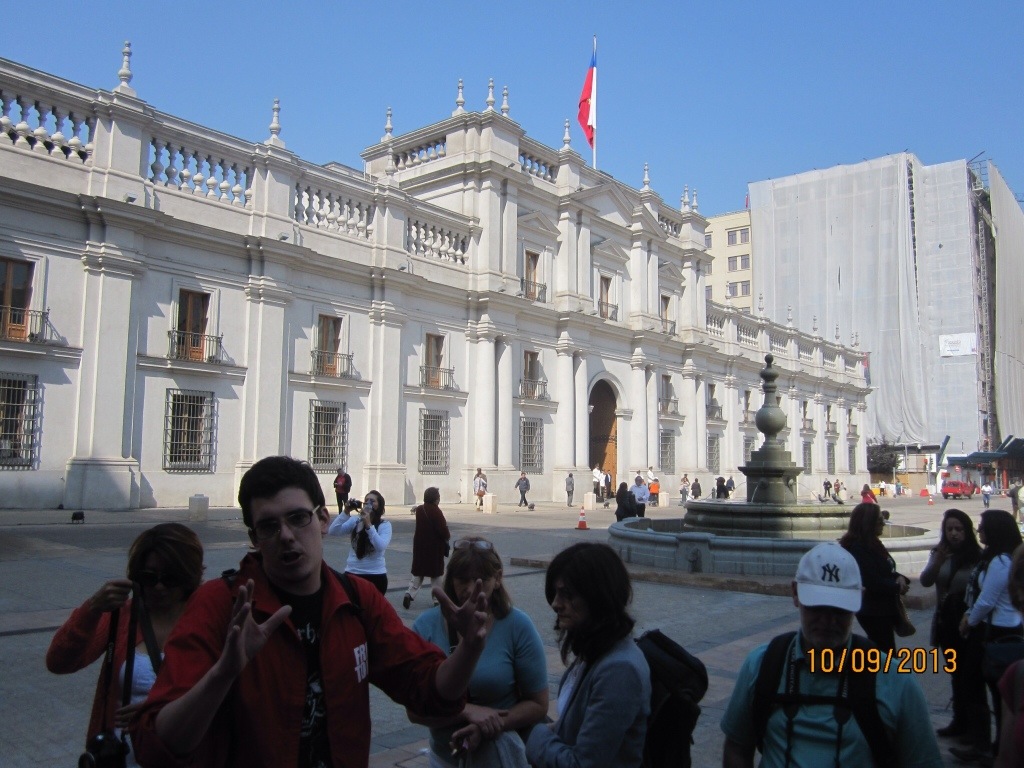
One of our tour stops was in front of Galindos, a Santiago restaurant in business for 45 years. It was there that Franco shared his insights into Chile’s food culture. A few Chilean dishes were called out by name as being very much worth tasting- Pastel de Choclo and Chorrillana, being two of them. On separate occasions we tried them. Pastel de Choclo (corn pie) was no better than “just okay.” (Pictured first, below.) The Chorrillana (with its topping of 2 fried eggs) was “God-awful,” in my opinion, and a “missed opportunity” in Jessica’s.
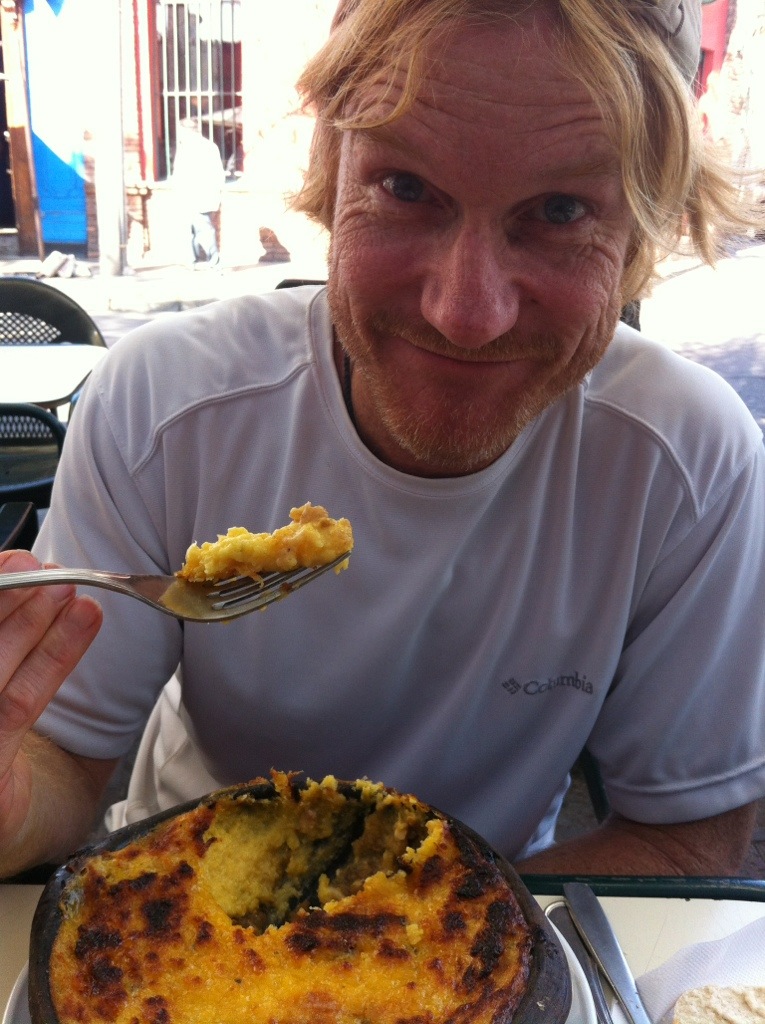
One item Jessica tried and liked is called Mote con Huesillos. It’s a kind of chilled tea poured over grains of wheat. Peach halves are added to the tea and hover in the glass like ice cubes. It’s a big hit among the locals because it costs only about $1 and is both a refreshing drink on a hot day and (practically) a meal. I tried it, too, but didn’t find it appealing.
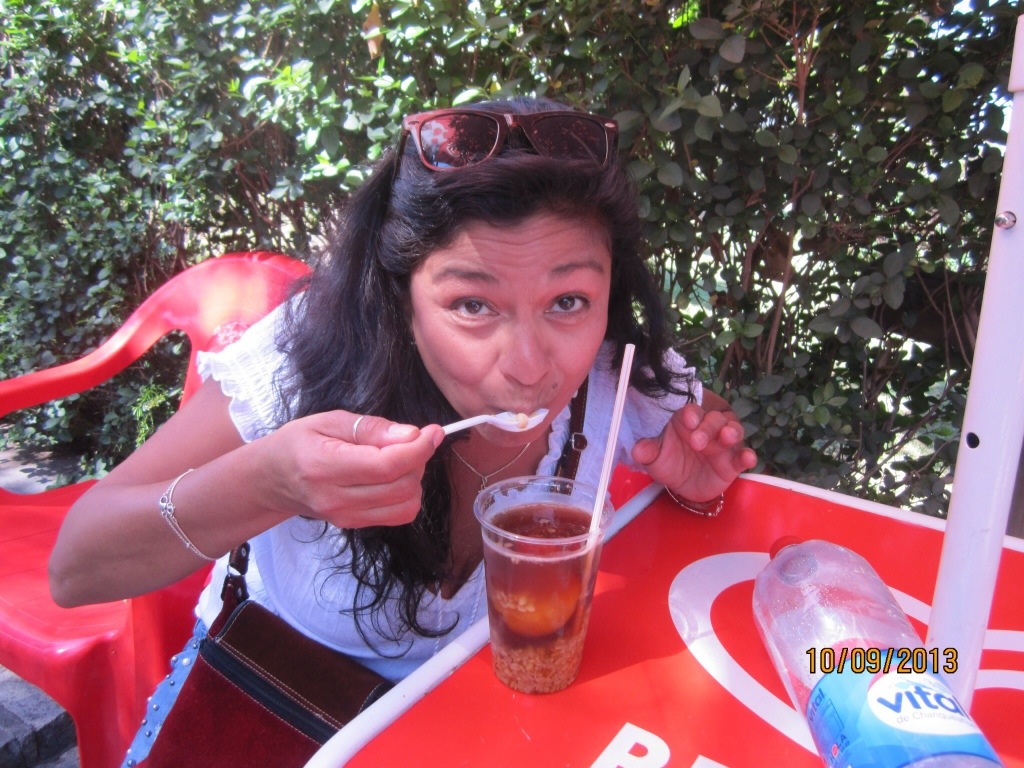
More sites from in and around Santiago. The ever-present Catholic Cathedral, General Valdivia- the founder of Santiago sits atop his steed, and so that you will never get lost….the mountains are always to the east.
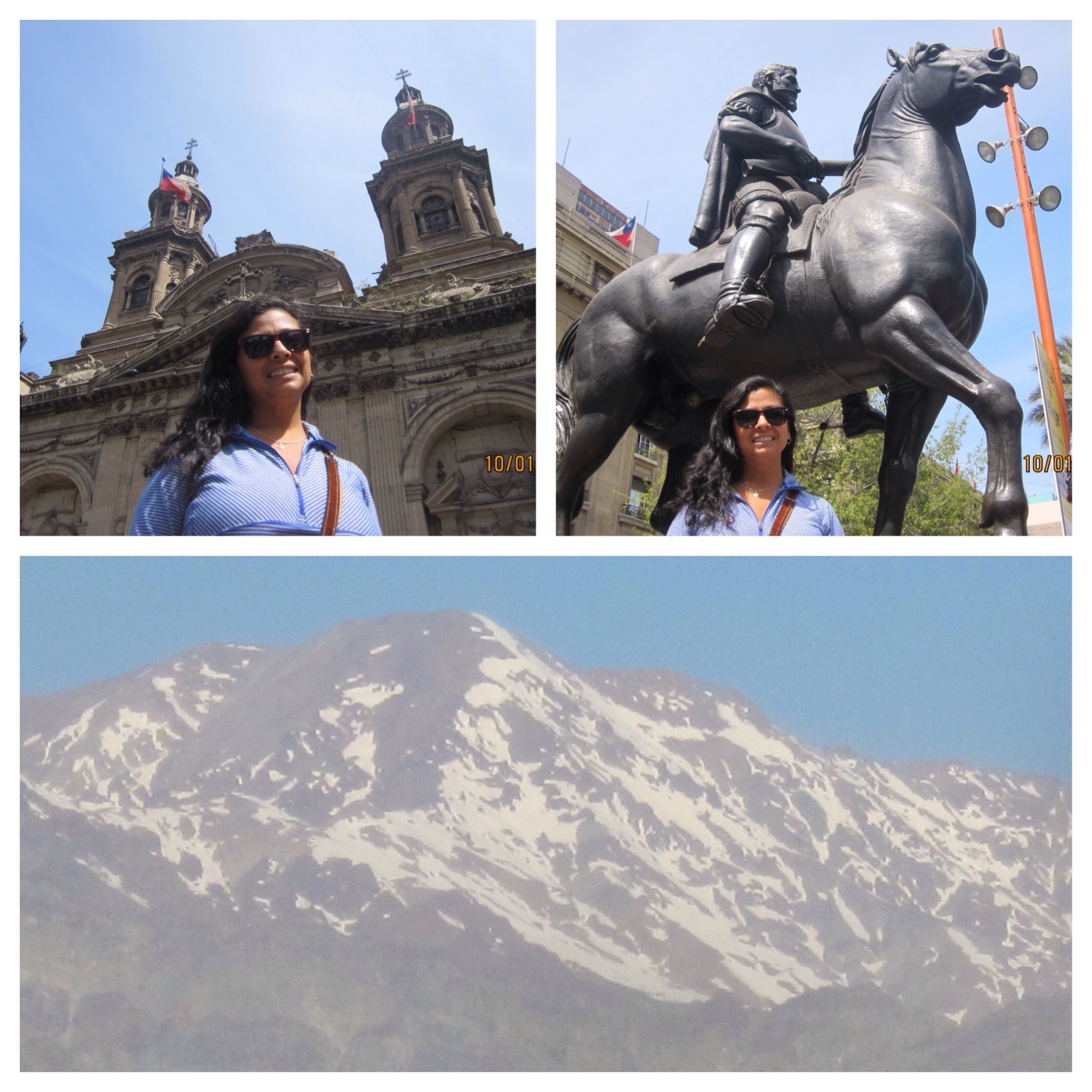
Santiago’s central fish market:
Time to Serve
One of our commitments during this trip was to do some volunteering. Taking so much time away from working real jobs and giving that luxury exclusively to ourselves seems a little decadent and perhaps even selfish. Let us at least set aside some of our time for helping others. The type of volunteering we wanted to do never truly solidified in our heads in advance of our trip, but we figured it might have something to do with teaching English to kids or contributing to a shelter for women, etc. What we learned, however, is that it’s really difficult to volunteer when you only have one month of your time to offer. One month barely gets you through the screening process. Volunteer projects involving people are understandably more hesitant about bringing in outsiders- wariness of creepers and the hassles of potential personality conflicts surely play a part in their caution.
Turns out that dogs and cats are less particular than people about who helps them and for how long….so guess whom we started scratching to satisfy our volunteer itch. There are two separate but related animal rescue organizations that operate not too far from where we live, one for dogs and the other for cats. We’ve been enough times now that the dogs have started to recognize us. The cats…less so.

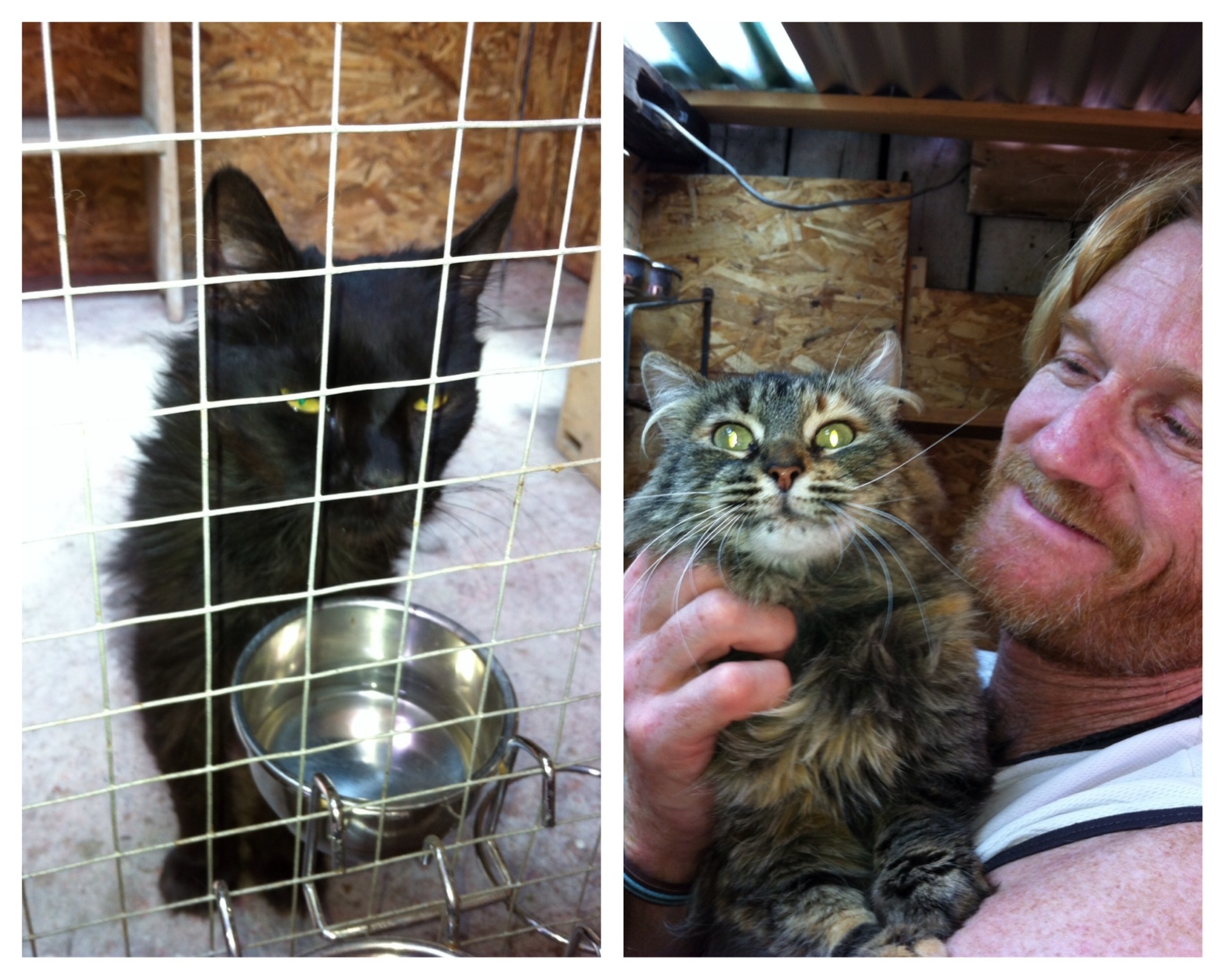
Another impromptu bit of community service we took on was cleaning up a particularly litter-strewn street we routinely walk down on our way to the grocery store. Santiago is not a “dirty city” and I don’t want to leave you with that impression, but there are definitely some areas that could use a little picking up.
Good Dogs and Stupid People
It’s hard to know where to begin telling you about Chile’s dogs. Perhaps a few quick sound-bites will get you oriented. There are a (relatively) large number of homeless dogs living in Chile’s major cities. Almost all of the street dogs we saw appeared healthy and happy. The dogs we met were sweet, friendly, approachable, non-threatening, and often quite good-looking. Most would make outstanding family dogs. The only thing missing was the family.
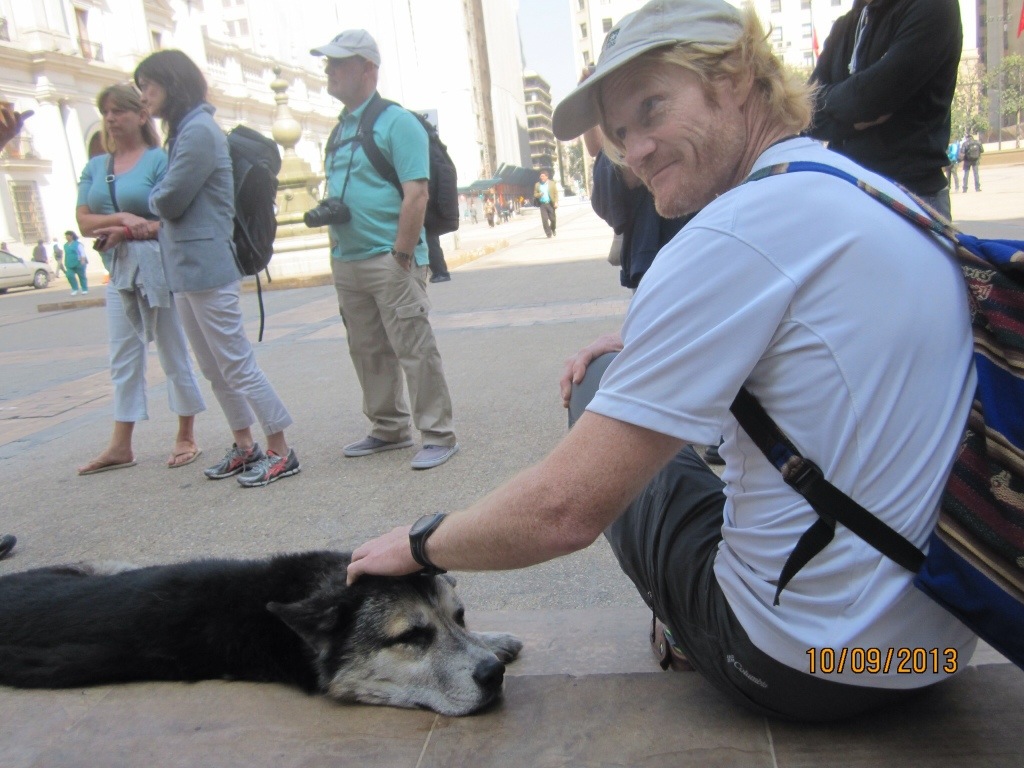
My street dog collage.
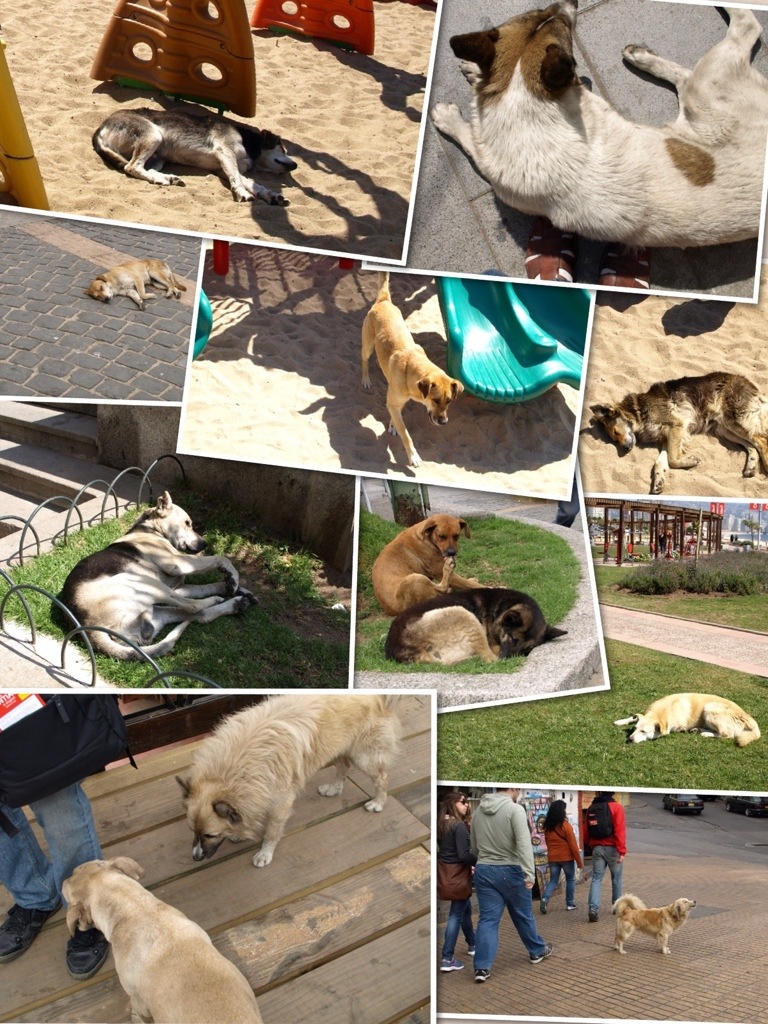
Where do all of these dogs come from? The story we got was that a lot of Chilean people are really “stupid” when it comes to their dogs. Families adopt them when they are small, cute and lovable little puppies, but they underestimate the lifelong responsibility they have assumed and abandon them to the streets once they are grown or otherwise become too much trouble. Obviously, this should not be taken as an indictment of all Chileans…only the stupid ones. Many Chilean people have dogs and take great care of them throughout their lives. Go anywhere in Santiago and you will see someone out walking their beloved dog.
Apparently the problem of stray dogs reached a level that the good people of Chile simply could no longer ignore because starting a few years ago both public and privately-funded campaigns have targeted the problem and achieved quite remarkable results. Below is a public sign that announces a new city ordinance banning the practice of abandoning your pets. One part of the signs say, Santiago Take Care of Your Pets.
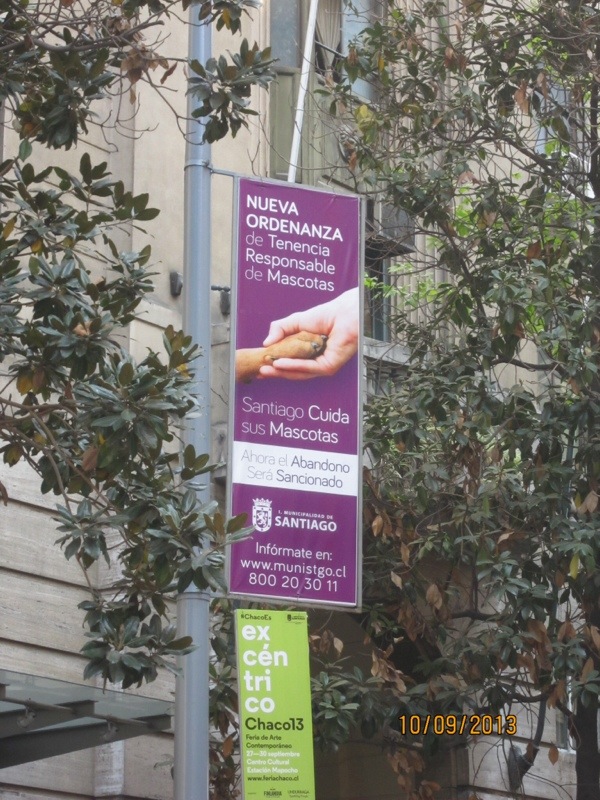
Changing a culture is not instantaneous, but it can happen more quickly than you might think. One of the principle volunteers at the Ñuñoa Dog Rescue Center told us the number of abandoned dogs in Ñuñoa has dropped significantly in just the four years since the center opened. The spaying and neutering of strays has been effective, but so has their more general efforts to educate people and change the perception of dogs as pets.
One creative campaign to bring attention to the problem was initiated by a couple of college students in 2012. What they did was write messages on helium-filled balloons and then tie them around the necks of the stray dogs. The messages said things like, “Hug me,” “Don’t leave me” and “Play with me.” Of course, they made a video of it to spread their message even further.
The unifying theme of the stray dog campaigns is that these dogs belong to ALL Chileans. We heard that during the coldest winter months, random people will provide the dogs with sweaters, jackets and sometimes even stylish matching hats.
Meet Elena and her dog Gypsy. Elena was a good-good friend of my mother when they both lived in Houston some 20 years ago. Elena is Chilean and returned to Chile after she retired. We enjoyed paying her a visit.

(Come back for Part 2)

